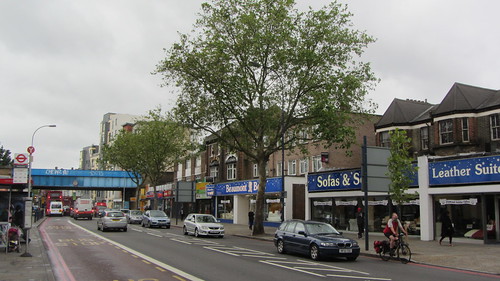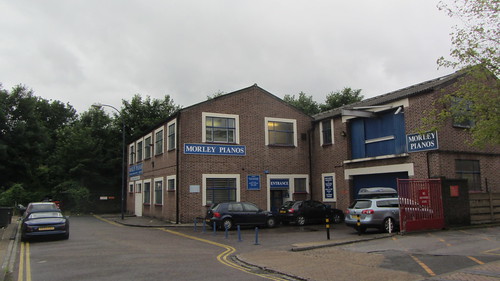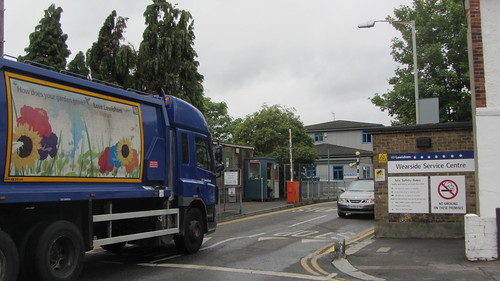Building a key interchange for inner South East London, similar to Stratford or Clapham Junction, would have many benefits to the area. This blog expores a proposal to develop Lewisham Junction as that interchange.
Lewisham Junction
Lewisham Junction is a proposal for a brand new station on a new site on the south side of Lewisham town centre. This blog explains the rationale for the site choice and how it could be developed.
The first thing to note is that Lewisham Junction is a separate site to the current Lewisham station. The current Lewisham station suffers from a complex flat junction and curving platforms, with little room to make alterations. It is not a practical place to expand or convert into a major junction. That said, the existing station, referred to here as Lewisham (North), is already a reasonably major junction, with lines to Victoria & Blackfriars, Charing Cross & Cannon Street, the DLR, Hayes, Chislehurst, Sidcup, Bexleyheath and Charlton.
The Lewisham Junction site is known to the railway as Courthill Loop Junction. To locals, it is to the west of the river at the south end of the High Street. The map hopefully clarifies the location:
This location is closer to the centre of the High Street than the current Lewisham station. And this access could be dramatically improved as part of building the station by opening up the south end of the shopping centre, across Molesworth Street.
While much of the core land is in railway ownership, the access land is not. The southern part of the High Street and Engate Street would ideally be totally redeveloped to provide good access, including for buses.
The station itself would need 4 platforms on the main-line and 2 platforms for the slow lines to Sidcup and Chislehurst. There would also need to be 2 platforms on the Hayes line that runs at right angles to the main-line under the site. (4 platforms are needed on the main-line to allow a train to pull into one platform while another train is pulling out of the other one).
Key to keeping initial costs down would be to no longer provide for trains to run from Hayes to London direct from Ladywell via the "short cut" on the western part of the site. All Hayes trains would have to go via Lewisham (North). Similarly, there would no longer be a connection from Hither Green to Lewisham (North). All Sidcup and Chislehurst services would run "straight on", avoiding Lewisham (North). This change to the services requires that the DLR is extended to Lewisham Junction, so that passengers from Sidcup and Chislehurst can still access Greenwich and Docklands (extending the DLR south of Lewisham North is not simple, but nor is it impossible).
Note that Lewisham (North) would remain open and unaltered with this proposal, serving that area of Lewisham.
Benefits
The real question is what have we gained through this scheme?
The benefits to the railway are simpler operation around the Lewisham area. The Hayes and Sidcup/Chislehurst lines have clearly defined routes/destinations, with less need for complex timetabling. Specifically, there is relief of the Lewisham flat junction, which would allow more Blackheath services. These railway benefits are important, providing a step change in capacity. However, there are much larger benefits around regeneration, with longer term benefits.
Next to this site is Wearside, a Lewisham Council Depot. This is a large plot of land that would suddenly be located next to a key railway junction, with fast access to London. Using this land to drive a major regeneration project would be key to the whole scheme. In addition to the Wearside land, there would need to be concerted effort to completely redevelop the southern end of Lewisham High Street. It would also make sense to redevelop Riverdale House, a nearby office building.
Finally, the main shopping centre would need to be opened up to the south, no doubt providing a major boost to retail in the centre. With the increase in people travelling only by publc transport, and not owning a car at all, improving public transport access to urban shopping centres is of increasing importance.
If these redevelopments could be linked together, there may be a surprising aount of money available to fund the scheme.
Some pictures that may help set the scene.
The southern end of the High Street, station site on the right, ideally replacing this row of shops:
Engate Street, behind the High Street. The station site would include this area, requiring demolition of this building and using land further to the right (the High Street is to the left):
Wearside depot, targetted for redevelopment:
The heart of the site itself, taken here from behind Riverdale House:
Longer term
Stratford and Clapham Junction stations are the models that this proposal looks to. Stratford in particular, didn't start as the huge interchange that it is now. Over time, other railway lines came to Stratford, the DLR twice and the London Overground. A key interchange becomes an attractor that reinforces the location.
In future entries I will look at some possible options that would reinforce the "junction" nature of Lewisham Junction, creating the hub for South East London that is needed, but cannot be built at Lewisham (North).
Summary
The current Lewisham (North) station is a reasonable junction, but cannot be expanded. This leaves the Lewisham Junction site, an opportunity for regeneration over a large part of Lewisham town centre and through the Wearside depot to Ladywell. Something that could change Lewisham forever.





i like it - but would take an enormous amount of political capital.
ReplyDeleteThats why the regeneration aspect is so important. That tends to be what drives larger schemes.
DeleteI'm not convinced. My view is that the station *and* the junctions surrounding it are all part of the same problem. The four-track Lewisham bypass viaduct is a massive Edwardian fudge. All these structures combine to constrain Lewisham's town centre unnecessarily by ringing it with multiple viaducts and bridges / pigeon nesting sites. A key problem is that damned bypass, which inherently reduces Lewisham's value as an interchange, affecting the CBR for any extensions to tube lines and the like via the station itself. Any new station *must* provide a complete interchange solution, with future-proofing for any propose / planned extensions through the site.
ReplyDeleteI don't have a blog, so I don't have anywhere to post maps and pictures, but my preferred solution is a 'big bang' multi-stakeholder, multi-phase regional project that would provide massive benefits not just for rail and (future) tube routes through the area, but also offer more opportunities for regeneration and development (which help to pay for it all), as well as major improvements to the region's road and cycling infrastructure. All surrounding boroughs would benefit, not just Lewisham. Furthermore, TfL would gain major road improvements, as well as a more streamlined LOROL network, not to mention an better CBR for routing any Bakerloo line extension through Lewisham rather than elsewhere.
Although it sounds like an outlandish concept at first, it actually makes more sense than any locally-focused alternatives, which tend to suffer from forcing NR and the local council to pay for (most of) it up-front all by themselves.
My solution is to push as much of the railway infrastructure in the area underground. And I really do mean all of it, including the many approaches and junctions. I'll post a full proposal on my website as soon as I've drawn the necessary diagrams. (The text is done.)
I look forward to reading your ideas. I certianly agree that if you push everything underground you have more flexibility, but obviously that comes with a large cost, both purely financial and in political capital.
DeleteI believe that the site above can work very effectively, effectively leaving the existing station to be primarily for the Blackheath route. I have other ideas for Hayes which aren't public yet. So, viewed as a single blog post it probably makes less sense than the complete plan I'm thinking of.
My main objection to this kind of proposal is that it limits the Lewisham Junction station's usefulness as a true interchange between National Rail services, which is why Clapham Junction is so successful.
ReplyDeleteEvery morning, people pile off Charing Cross-bound trains to switch to those headed for Victoria (which come from the Blackheath branch) and vice versa. With these proposals, that opportunity is gone.
And on top of that, with Lewisham North remaining open and still taking all the Blackheath-bound services (of which there are a lot, as the line splits after Blackheath), the new Lewisham station would have, it seems, rather a low number of services, unless you make a bunch of the current 'fast' trains into stoppers, which seems unnecessary.
I do also question how you would extend the DLR to the new Lewisham Junction station. The current DLR lines end at a main road. You'd have to get over (or under) it somehow, and that seems... difficult.
The real question for me is why they get off the Charing Cross service to change for a Victoria one? The major employment areas are equally accessible, if not more accessible, from Waterloo East and Charing Cross. Victoria, is really not the most central of London termini. Perhaps, those people are going somewhere else? Denmark Hill hospital traffic? Peckham shopping? Maybe you can enlighten us, because it seems like an orbital route, not a radial one to me.
DeleteThere is more that can be done to make Lewisham Junction interesting, but it requires more blogging time!
Bit late I know, but part of the answer to your question is they are going to Denmark Hill to get overground and other services. Denmark hill makes it possible to commute to places like Clapham and other parts of south/SW London avoiding central interchanges.
ReplyDelete